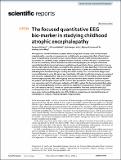| dc.description.abstract | Although it is a normal involution process in advanced age, brain atrophy—also termed atrophic
encephalopathy—can also occur prematurely in childhood as a consequential efect of brain tissues
injury through trauma or central nervous system infection, though in both normal and premature
occurrences this condition always presents with loss of volume relative to the skull. A common tool
for the functional study of brain activities is an electroencephalogram, but analyses of this have
reportedly identifed mismatches between qualitative and quantitative forms, particularly in the use
of Delta-alpha ratio (DAR) indices, meaning that the values may be case dependent. The current study
thus examines the value of Focused Occipital Beta-Alpha Ratio (FOBAR) as a modifed biomarker for
evaluating brain functional changes resulting from brain atrophy. This cross-sectional design study
involves 260 patients under 18 years of age. Specifcally, 207 patients with brain atrophy are compared
with 53 control subjects with CT scan-proven normal brain volume. All the children underwent digital
electroencephalography with brain mapping. Results show that alpha posterior dominant rhythm
was present in 88 atrophic children and 44 controls. Beta as posterior dominant rhythm was present
in an overwhelming 91.5% of atrophic subjects, with 0.009 p-values. The focused occipital Beta-alpha
ratio correlated signifcantly with brain volume loss presented in diagonal brain fraction. The FOBAR
and DAR values of the QEEG showed no signifcant correlation. This work concludes that QEEG
cerebral dysfunctional studies may be etiologically and case dependent from the nature of the brain
injury. Also, the focused Beta-alpha ratio of the QEEG is a prospective and potential biomarker of
consideration in studying childhood atrophic encephalopathy | en_US |

